American Foulbrood (AFB) and European Foulbrood (EFB) are very different diseases that can affect honey bees, but they have some key similarities: They are both caused by a bacterial infection of the brood, and they cause the brood to die and stink (hence the word "foul" in the names). The bacteria are completely different species, but they're both bacteria and they can both kill colonies.
EFB is often (but NOT always) something that a colony can recover from with a good nectar flow or syrup feeding by the beekeeper. Particularly stressed colonies, or colonies with more deadly strains of EFB may die, but proper management is usually enough to help a colony with EFB recover.
AFB is usually a death sentence for a colony due to the rapid spread and the amount of brood killed by the infection. In addition, AFB is extremely contagious and produces long-lived bacterial spores in the hive, and when a bee eats one of those spores even 90 years later the bacteria inside are released and start reproducing again. This means reusing equipment from an AFB colony even decades later can easily lead to a new outbreak. For that reason, most states mandate that any colony with a confirmed case of AFB be euthanized and the entire hive (boxes, frames, honey, bees, and all) be burned in a pit to prevent spread to other bees nearby. So the infection itself can kill the colony, but often the colony is killed by the beekeeper to protect their other hives.
It is critical to know if your colony is infected with a foulbrood disease, and to know which disease they're infected with too.
Rapid Test Kits - Great, but unavailable
Betterbee has been proud to offer rapid test kits, one for EFB and one for AFB, manufactured in Europe. If you have any experience with rapid COVID tests or at-home pregnancy tests, you'll be familiar with the basics. A liquid sample of whatever you're trying to test is measured out into the testing device, and as the fluid moves through the device some number of lines appear. Usually, one line is there to tell you whether the test result is positive, and the other line is there to let you know that the test isn't completely broken. Two lines is a positive test result, one line is a negative result (but the test worked properly), and no lines means that something has gone very wrong and you need to test again.
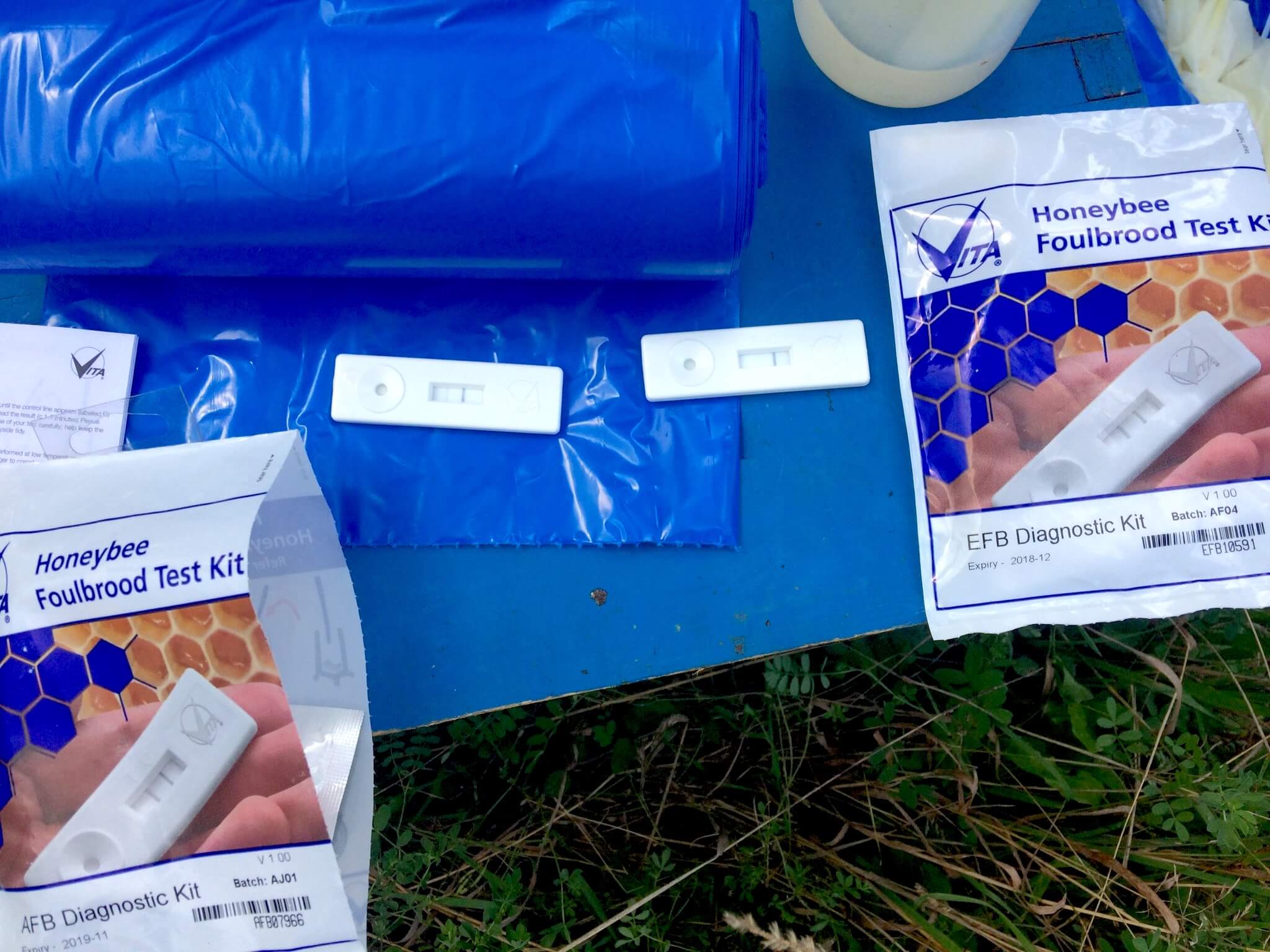
The faint second line on the AFB test kit (left) shows that the sample run through both tests was positive for AFB, and negative for EFB.
These rapid test kits are a fantastic tool, because they let beekeepers try to identify and distinguish between these diseases at home. They are also very useful to state bee inspectors, who often carry them to quickly check hives in the field that show suspicious symptoms. Early detection can give you a headstart in fighting back a disease outbreak.
Unfortunately, due to federal government regulation and a lack of the proper paperwork having been filed, Vita Bee Health is not able to ship any more of these kits into the United States. It's not clear when they'll be available again, but it's expected that they won't be available for at least a few months, if not longer. Until the regulatory paperwork is sorted out, we beekeepers have lost a useful tool in the fight against bacterial diseases in our hives.
But there's no need to despair! There are other ways to try to test bees for these diseases.
Start with symptoms
Of course, the best clue about whether your hive is fighting AFB is if the colony has obvious symptoms of AFB infection. AFB and EFB both have recognizable (and quite different) symptoms, and knowing the symptoms of each will help you recognize when there may be trouble. Dead and dying brood in the hive, an unpleasant odor, and a weakening colony should cause you to pay attention. EFB tends to kill larvae prior to capping, while AFB tends to kill after the cell is capped. A bad EFB infection can have a slightly sour odor, while AFB tends to smell more like sewage. Larvae killed by either disease will sometimes die and dry in the cell into a kind of thin "scale," but EFB scales can be easily scraped out of the cell while AFB scales cannot be easily separated from the wax. An active case of AFB will lead to many dead and dying open and capped brood, and their decomposition produces the characteristic foul odor. Note that in old infected equipment the odor will be gone and there will be no brood to inspect, but the scales (the skins of the liquified dead brood) will still remain, so a good beekeeper should be able to recognize them.
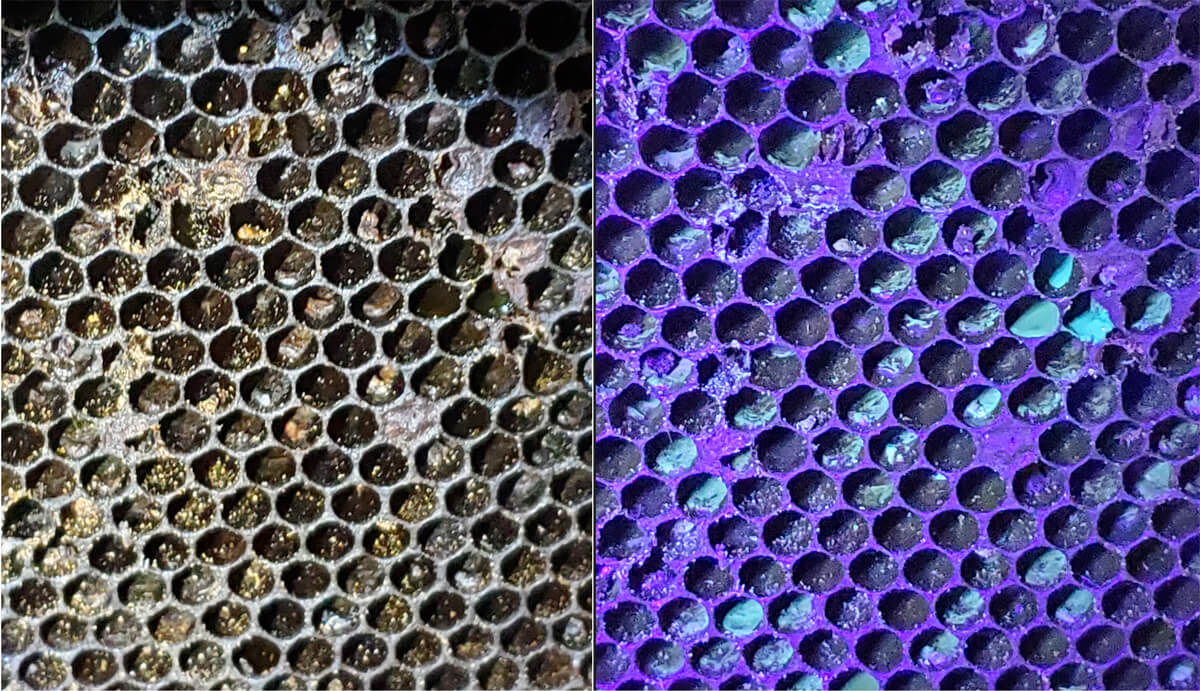
AFB scales stuck firmly to the bottoms of the cells are a clear sign of a past infection. They fluoresce under a black light flashlight, which can be helpful in spotting or recognizing them.
Lab testing
The best way to be sure whether or not your bees have AFB is laboratory PCR testing. The USDA Bee Lab in Beltsville Maryland provides a free (tax-funded) Bee Disease Diagnosis Service for anyone in the US. Samples of comb mailed to Beltsville are screened for bacteria, viruses, and parasitic diseases (like nosema). Many state bee inspectors send samples to the Beltsville lab, even if they've done a rapid test to get an idea of whether they're looking at AFB or not. Unfortunately, this free public service is frequently subject to delays, and if you think you have AFB in a hive you don't usually want to wait weeks for an answer. The lab also has strict rules for the samples that they process, and may reject samples that are packaged improperly.
A few state apiary inspectors also have funding to pay other labs to run tests for AFB and sometimes other diseases, but this varies from state to state. You can see if your state bee inspector or department of agriculture offers any kind of testing, though most will probably direct you to the USDA lab in Beltsville.
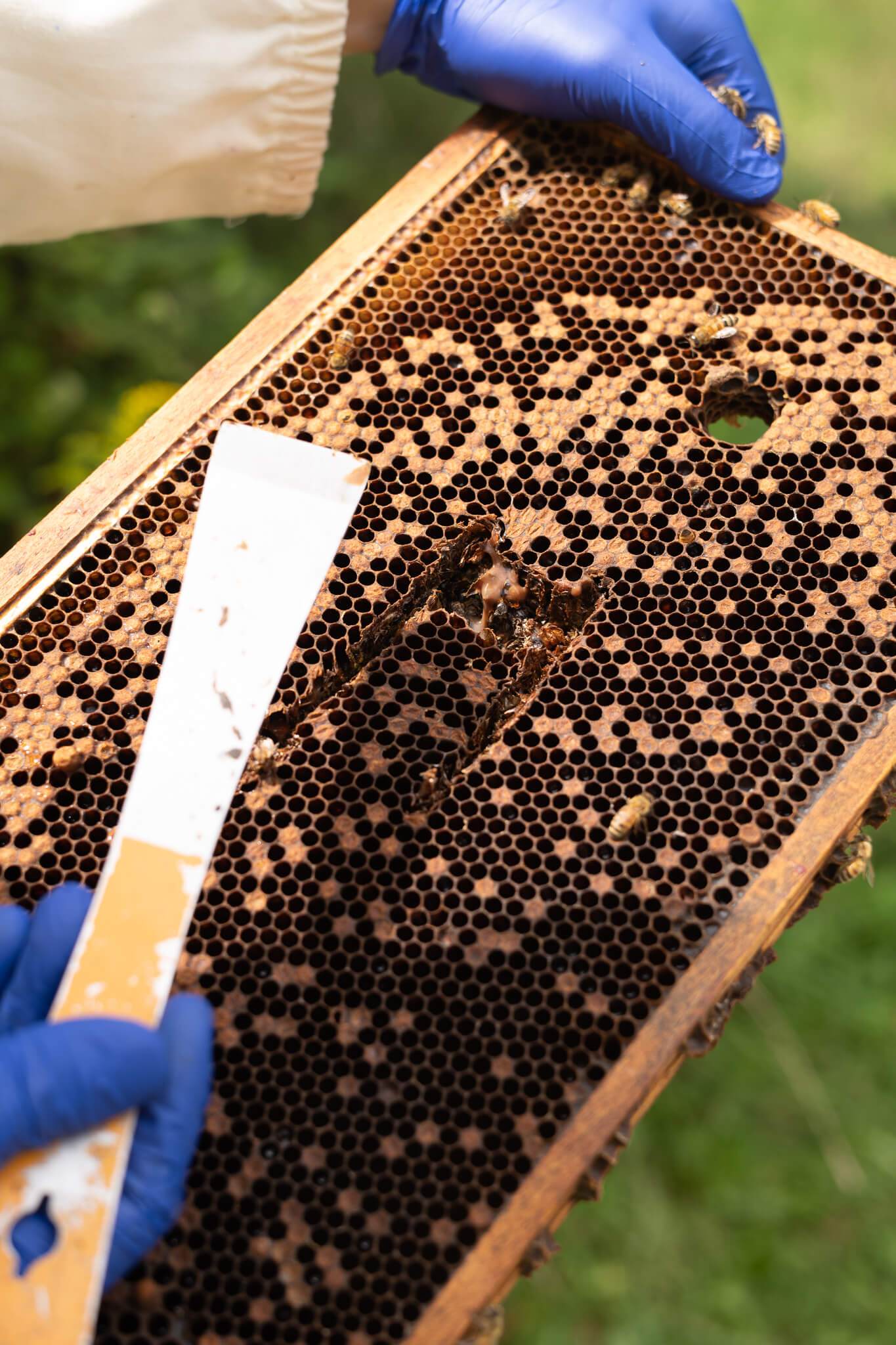
A hive tool can help you cut a square comb sample for testing in Beltsville. Be sure to wear disposable gloves and thoroughly sanitize your tools, bee suit, boots, and anything else that could spread spores to other hives.
At-home testing - The Ropiness Test
One indicator of AFB infection is to find a dead larva that you think has been killed by the disease and test its "ropiness." If the larva died of AFB it will "rope out" of the cell (come out in a long continuous strand) when poked and stirred with a piece of grass. A positive ropiness test is not a guarantee of AFB, but it's a very useful field test. (Make sure the piece of grass or stick that is used to test larvae is safely destroyed and cannot spread spores to another colony!)
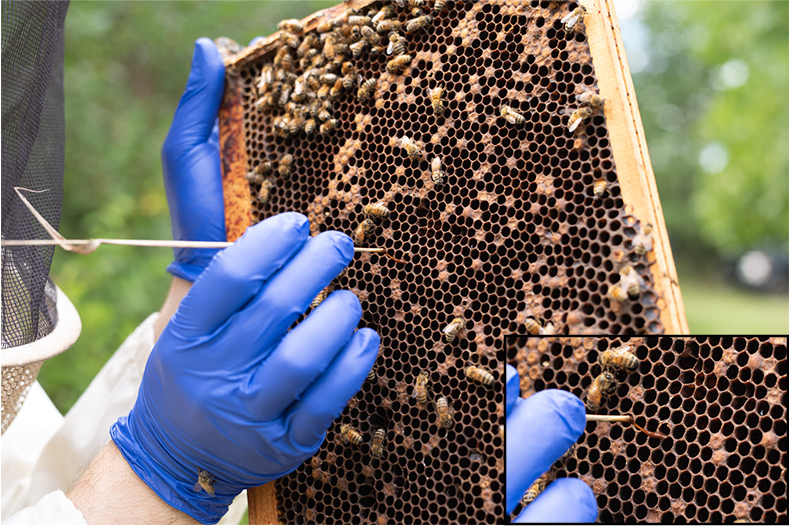
Betterbee's Dr. Peck uses a piece of grass to show the "ropiness" of brood killed by AFB. Note that this was not a Betterbee hive, but instead a hive that Dr. Peck assisted in correctly diagnosing AFB
At-home testing - The Holst Milk Test
In 1946 USDA scientist E.C. Holst published an article in the American Bee Journal titled "A simple field test for American foulbrood." That test, the Holst milk test, can still help determine whether brood have been killed by AFB or something else.
The key to Holst's test is that the AFB bacterium releases an enzyme that digests the proteins in the dead bee's body to create a kind of gluey substance. This glue is also why the larva becomes ropey, and why dried larvae form a scale that sticks firmly to the inside of the cell, ensuring that AFB spores will remain despite the cleaning efforts of the hive's bees. This protein-destroying enzyme is not specific to bee proteins, and will also digest milk proteins. Holst's test originally recommends using powdered milk, though most beekeepers these days are happier to just use fresh milk. (Either will work just fine.)
A simple version of the test looks like this:
- In a test tube (or similar small disposable container) combine 20 drops of water and 10 drops of skim milk (or reconstituted powdered milk.) It is useful to prepare a second tube to use as a control for comparison to your test vial.
- Take one discolored larva that you suspect may have been killed by AFB, or a scale from the cell wall of a suspected AFB hive, or even the goo-covered blade of grass that you used to perform the ropiness test above. Mix your sample into the milk tube you prepared in Step 1.
- Keep the tube warm (roughly human body temperature is ideal) for at least 15 minutes.
- Examine the fluid in the tube. If the milk has separated and become clear, leaving a sediment and a clear yellowish liquid, it means that the AFB protein-digesting enzyme is present, and the milk proteins have been digested by it. This is a positive (that is, bad news) test result.. If you prepared a control tube with just water and milk, it should be easy to compare and spot the difference. If the milk does not clear, it was likely not AFB that killed your bees.
As Holst pointed out in 1946, the materials to perform hundreds of these tests cost mere pennies to acquire.
Be careful of false positives and false negatives
Remember that no test is foolproof. A test performed in your apiary using a blade of grass or some milk is more likely to produce errors than a test performed by a specialized kit or in a government laboratory. There is always a risk of a false positive result (when the test says the colony is infected but is not) or a false negative (when the test says you're in the clear but the colony really is infected.) Of these, a false negative for AFB is much scarier, since the negative test result will protect a colony with sick brood from being destroyed, likely allowing the bacteria to spread. The most reliable testing plan is to use multiple tests, and to act when more than one reliable test agrees with the results of the others.
We're not sure when kits will be back, but no need to panic
With the ropiness test, the Holst milk test, and access to disease testing laboratories a beekeeper, inspector, veterinarian, or researcher can still check for AFB inside a hive. EFB diagnosis is harder without the ready-to-use field test kits, but EFB is usually less serious than AFB and a good familiarity with the symptoms can provide useful diagnostic insights.
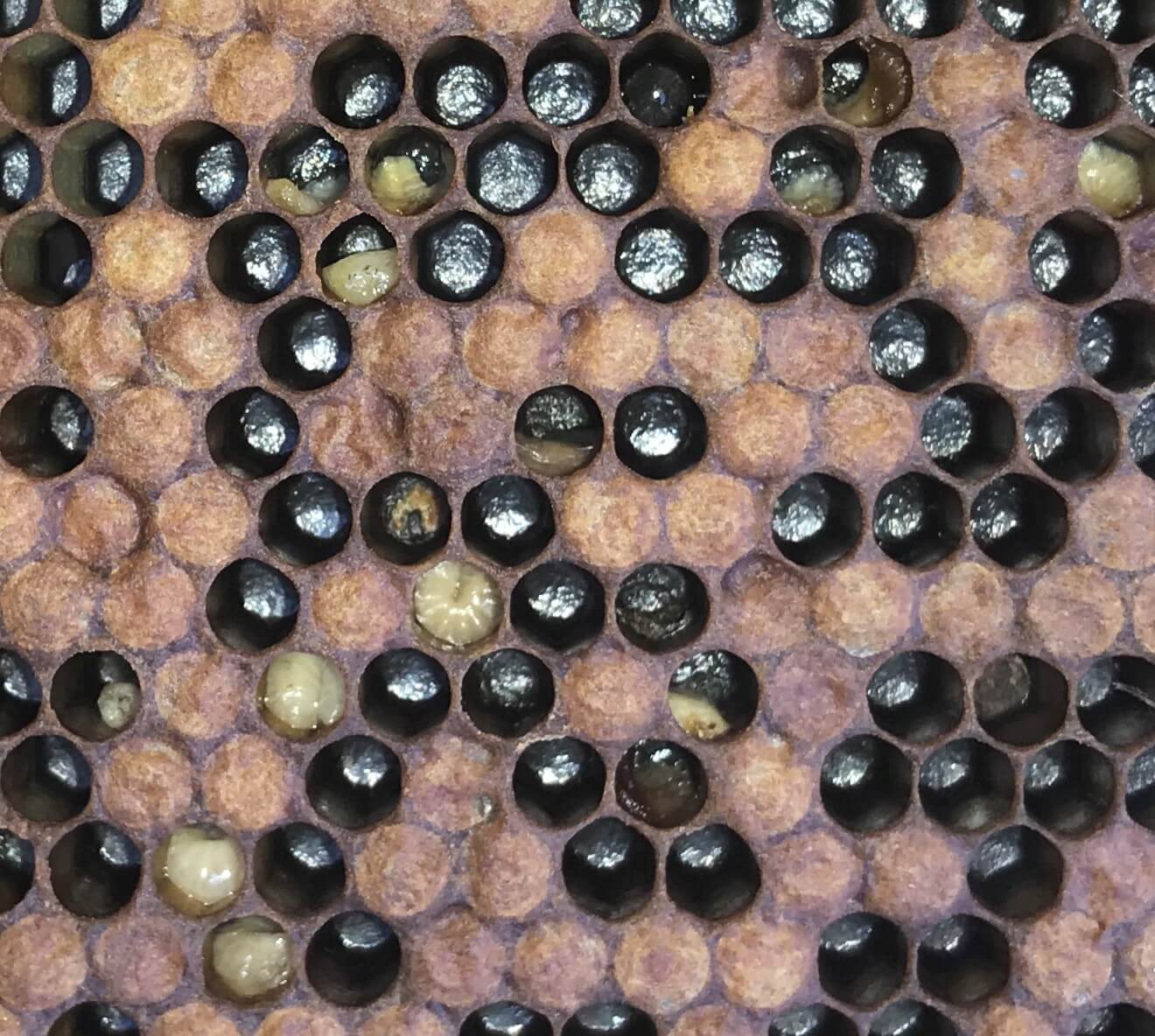
Here you can see larvae dying from EFB - European foulbrood - and not AFB. The larvae are slightly yellow and twisted.





